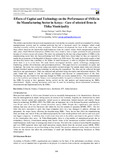| dc.contributor.author | Gathogo, George M. | |
| dc.contributor.author | Ragui, M. | |
| dc.date.accessioned | 2020-01-10T05:51:20Z | |
| dc.date.available | 2020-01-10T05:51:20Z | |
| dc.date.issued | 2014-01 | |
| dc.identifier.citation | European Journal of Business and Management, Vol.6, No.7, 2014 | en_US |
| dc.identifier.issn | 2222-1905 | |
| dc.identifier.uri | https://www.researchgate.net/publication/261509378_Effects_of_Capital_and_Technology_on_the_Performance_of_SMEs_in_the_Manufacturing_Sector_in_Kenya_-Case_of_selected_firms_in_Thika_Municipality | |
| dc.identifier.uri | https://www.iiste.org/Journals/index.php/EJBM/article/view/11470 | |
| dc.identifier.uri | http://business.ku.ac.ke/images/stories/research/dr-raguri/effects-of-capital-technology.pdf | |
| dc.identifier.uri | http://hdl.handle.net/123456789/4386 | |
| dc.description.abstract | The global concern about the persistent stagnation and even decline in economic growth accompanied by chronic unemployment, poverty and its resultant problems has led to increased search for strategies which could stimulate economic activity in many economies. Small business development has been at the centre stage of these efforts based on the notion that small businesses form the context within which entrepreneurial activity takes place. Small Medium Enterprises (SMEs) have been found to have a higher potential for job generation because of a lower cost per job created. The study was prompted by the fact that a large number of SMEs in the manufacturing sector have not been performing well while others have closed shop yet they are expected to enable the government of the Republic of Kenya to achieve its 2030 vision. The study particularly sought to find out those key factors that contribute to the failure of small businesses in order to enlighten the entrepreneurs about them so as to avoid them. The main factors investigated includes: capital, technology, management, franchising, product diversification, and government policies. This paper however concentrates on capital and technology. The study was carried out using a descriptive research design. The sample under study was collected through stratified random sampling technique in selecting the respondents. The data was the collected through interviews and questionnaires. Data was analyzed and presented using descriptive and inferential statistics. The study found that capital is vital for superior performance and increase of competitiveness of the firm. Technology was also found to be important though the SMEs are mostly manual driven. The recommendation are to have policies governing the finance sector and particularly in regard to collateral. Government can assist the SMEs by acting as their guarantor having carried out the risk analysis and mainstreaming the SMEs identification. Higher learning institutions could also be used for technology driven information incubation, dissemination and implementation by the SMEs. | en_US |
| dc.language.iso | en | en_US |
| dc.publisher | IISTE | en_US |
| dc.subject | Collateral | en_US |
| dc.subject | Finance | en_US |
| dc.subject | Competitiveness | en_US |
| dc.subject | Incubation | en_US |
| dc.subject | ICT | en_US |
| dc.subject | Industrialization | en_US |
| dc.title | Effects of Capital and Technology on the Performance of SMEs in the Manufacturing Sector in Kenya -Case of selected firms in Thika Municipality | en_US |
| dc.type | Article | en_US |

